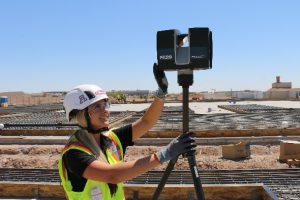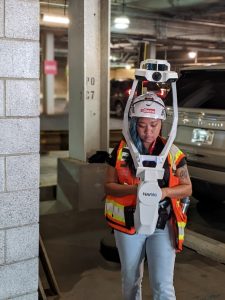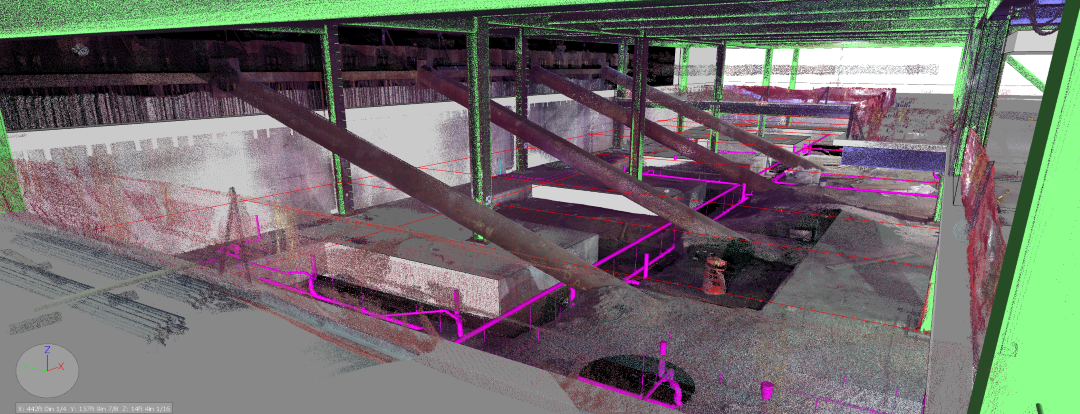What is laser scanning?
To provide the maximum value to our clients, projects and people, Gilbane’s virtual design and construction (VDC) team is constantly searching for solutions that can integrate with existing process software and hardware, while also keeping Gilbane at the forefront of construction technology.
One of the most valued services our VDC team provides is laser scanning. This technology can do everything from documenting and verifying existing conditions to assessing the quality of work in progress. It can even check floor flatness. We currently deploy terrestrial, static tripods which direct a laser in a straight line to measure distance. The scanner produces a “point cloud” file which plots points in space to create an almost 3D model-like file. A highly detailed and accurate model can help our projects run smoothly and achieve even the most demanding budgets and schedules.
 Limitations of current laser scanning technology
Limitations of current laser scanning technology
The pinpoint accuracy of our terrestrial tripod scanners makes them an irreplaceable and essential piece of hardware we utilize. But while laser scanning with the tripods is ultimately a very valuable process, it is also a tedious, complicated task that involves both onsite and office time to create a working deliverable. The tripod scans in a “line of sight”, meaning it cannot see around turns or obstacles. It must be set up in a location, perform a scan (about a ten-minute process), then moved to another location for another scan. This process is repeated over and over until the entire area is complete. A large area with walls and closed-in areas can require as many as 25-50 scans to “see around corners” and get a complete point cloud file. Achieving this many scans can take multiple days and may require coordination with onsite or owner activities, making scanning an occupied or sensitive jobsite during operating hours difficult to coordinate.
Once onsite scanning is complete, the data must be processed and registered (stitched together) using highly sophisticated computer software and processing power. Generally, one day onsite is one day in the office processing and registering the data. The data produces file sizes that can exceed 25GB each, which requires the computer software to use high-end processors and GPUs.
What is mobile laser scanning?
Gilbane’s VDC team is always looking to add tools to our toolbox to provide innovative solutions. With the purchase of the NavVis VLX, a new mobile laser scanner, Gilbane VDC hopes to deliver solutions to our clients by pushing the boundaries of technology and improving internal workflows. While terrestrial scanners are placed in a single static location, the new mobile laser scanner is a wearable device with 360-degree cameras and lasers that scan continuously as the user walks.
Instead of repeatedly repositioning a tripod to scan, the mobile laser scanner can scan an area in roughly the time it takes to walk it. A jobsite that previously would have taken hours, if not days, to scan can now be scanned in a matter of minutes. Not only is this process exponentially faster than the terrestrial scanner, but it also captures the same precise data – down to the tiniest fraction of an inch, even from hundreds of yards away. The mobile laser scanner also takes high-definition, 360-degree photos that the software uses to colorize and create additional imagery, essentially creating a “Google Street View” of existing conditions.
Once an area is scanned, the mobile laser scanner utilizes cloud-based technology to transform the data into a deliverable, automating what was previously a very time-consuming process. The software is capable of automatically detecting and removing unwanted obstacles like machinery or even people from scanned data. This means that laser scanning even a heavily occupied area, like a crowded train station, will result in a model without any people in it.
Embracing mobile laser scanning technology
The advances in speed and efficiency introduced by mobile laser scanning present new opportunities and workflows that add value throughout a project. Mobile laser scanning allows our VDC team to scan occupied jobsites with minimal impact or disruption to a client’s day-to-day activities. For example, it would be unsafe to block a corridor in an occupied hospital with a terrestrial tripod scanner – but the same space could be scanned with a mobile laser scanner without disrupting hospital operations. The speed and convenience of mobile laser scanning also enable our team to perform quality assurance and control of work in progress, which is generally not feasible with terrestrial tripod scanning’s lengthy time requirements. By comparing building information models (or BIM) and point cloud data, Gilbane can visually inspect and verify critical work in place, such as pipe penetrations or overhead mechanical systems, is being installed as intended.
Gilbane’s VDC team is currently utilizing mobile laser scanning on major renovation projects throughout the Mid-Atlantic, including a historic, 500,000 SF train station in downtown Philadelphia, PA and two large government buildings in Washington, DC. We are working closely with onsite teams to identify any opportunity where scanned data can create additional value. Mobile scanning can be used for more than quality control. The models can be used to improve logistics, subcontractor coordination, scheduling, pull planning – you name it.
The future of laser scanning
Laser scanning technology has come a long way over the past few years, and it will continue to deliver faster, more accurate information as technology advances. While mobile laser scanners will never replace our terrestrial tripod scanners, having different tools for the right applications brings value to Gilbane’s clients and projects. As the technology becomes more accessible and more familiar, Gilbane will be able to utilize it on more jobsites and in more project stages – helping to not only prevent costly delays and change orders but also opening the door to more prefabricated and modular components, which require precise measurements. This technology will undoubtedly result in greater efficiencies – and ultimately, more satisfied clients.

